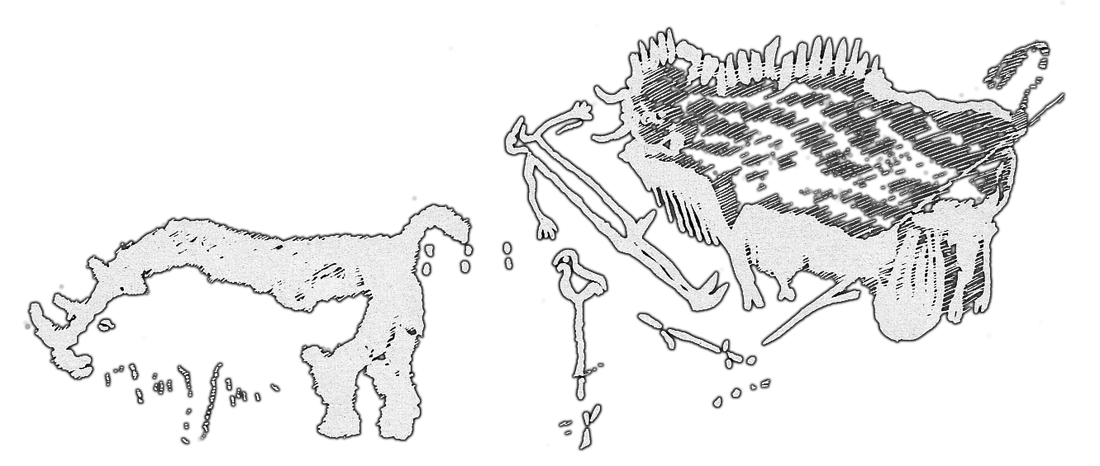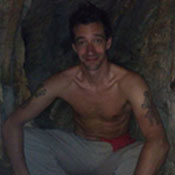In many ways, the often cited category of the ‘Palaeolithic cave painting’ is a clumsy term, not least because the phrase actually represents several widely divergent traditions visible in three discrete time periods (the early-to-mid Aurignacian, the Gravettian-Solutrean and the Magdalenian) stretching across nearly thirty thousand years of the European Upper Palaeolithic. As such, it is hardly likely that the same ritual functions and cultural imports of the paintings would have persisted unchanged for such a long time period – indeed important clues of these changes can be gleaned from the architectural spaces of the caves themselves and the siting of the art within them, as well as from the interactions between the cave sites, particularly in the latter two periods.
There are also huge changes within the art itself, and the famous images of animals of the Eurasian Steppe represent only one strand of a rich set of traditions whose varieties and subtleties are easily missed from within a casual purview. In the earliest periods, dots and tectiforms of unknown meaning seem to predominate, but by the late Aurignacian (30-28kYa B.P.) the familiar images of bison, cave lions, deer and others take centre stage, with human-animal hybrids making occasional appearances. In the Magdalenian, abstract claviforms accompany animal images but the usage of the cave itself seems to be transformed into public and private spheres in a manner not seen previously.
Campbell provides a neat summary of this “uncanny painting” which he holds as suggestive of the whole mystery underlying Palaeolithic cave art in general:
“Down there [in The Shaft] a large bison bull, eviscerated by a spear that has transfixed its anus and emerged through its sexual organ, stands before a prostrate man. The latter (the only crudely drawn figure, and the only human figure in the cave) is rapt in a shamanistic trance. He wears a bird mask; his phallus, erect, is pointing at the pierced bull; a throwing stick lies on the ground at his feet; and beside him stands a wand or staff, bearing on its tip the image of a bird. And then, behind this prostrate shaman, is a large rhinoceros, apparently defecating as it walks away.”
That the stylised figure can be regarded as bearing shamanic elements is evidenced by the association of the figure three times with birds – in the mask or hybrid bird-face, in bird figure atop the ‘wand’ or ‘staff’ and by the birdlike nature of the figure’s hands, a feature remarked upon by, among others, the Abbé Breuil. The association of birds with shamanic flight is a ubiquitous feature in modern hunter-gatherer cultures and shamanic lore from Siberia to North America, but the presence of the phallus and, perhaps more circumstantially, the figure’s posture, also point to the possibility of an ecstatic trance or altered state of consciousness. Lewis-Williams points out:
“…male erections are common in altered states and in sleep, and it is a peculiarly Western notion that the motif always stands for virility and fertility.”
The sketchy or stylised depiction of human figures in Palaeolithic cave art of all periods stands in stark contrast to the careful beauty enfolded in paintings and engravings of the animals, and this scene is no exception: the bison is shown in sharp detail, with its head lowered and fore legs extended backwards to suggest movement and tension in the animal. The ethnologist Leo Frobenius (quoted in Campbell) noted this feature some three decades before the discovery of Lascaux, and in a review of late Palaeolithic art from Saharan Africa, he remarked on the same contrast.
Early interpretations of this scene revolved around notions of this representing a hunting accident, and the Abbé Breuil advanced the idea that the cause of the disaster was the rhino. Campbell counters this from a mythological perspective which assumes a hunting magic function of paintings at Lascaux:
“… in a cave where the pictures are magical and consequently were expected to bring to pass such situations as they represent, a scene of disaster would not have been placed in the crypt [the Shaft], the holy of holies.”
The hunting magic idea for Palaeolithic cave art in general was persistent throughout the mid twentieth century, predicated mainly upon anthropological observations of hunter-gatherer peoples from sub-Saharan Africa, in particular the Pygmies of West Africa. Frobenius observed (again quoted by Campbell) that hunters would precede their voyage to the hunt with a ritual in which the hoped-for animal would be drawn upon rock or the earth and then struck with an arrow in imitation of his future actions. Thus, for Campbell, the Shaft Scene represented an image of hunting magic in which the prostrate Bird Man’s shamanic trance was intimately connected with the disembowelling of the bison to his right, and suggested the depiction perhaps of a ritual in which the shaman ensured the success of the hunt through his intercession with a spirit world.
“Black or hostile magic is predominantly phallic… If a man has been ‘boned’ his dream will show it. First he sees a crack, an opening in the ground, and then two or three men walking toward him within the opening. When they are near, they draw a bone out of their own body. It comes from the flesh between the scrotum and the rectum. The sorcerer, before he actually ‘bones’ his victim’, makes him fall asleep… The man who uses the bone holds it under his penis, as if a second penis were protruding from under him… The victim is asleep and the bone goes straight into his scrotum…”
Here we see a remarkable illumination of the Lascaux scene, assuming (and it is not entirely certain that we can) that a parallel can be drawn between the practices of modern-day Aborigines and Palaeolithic cave painters some 17,000 years ago. This dark magic ritual appears to resonate with many of the more perplexing features of the scene, in particular, the presence of the phallus and the method used to disembowel the bison.
Can such an interpretation, of potent hunting magic, throw any light upon the chosen location for this image, separated from the main cave areas by being located at the base of a shaft the entrance of which is located in a recess? Clottes notes that the Shaft is prone to high levels of carbon dioxide, which may cause hallucinations and altered states of consciousness engendered by the discomfort of hypoxia.
Interestingly, Lewis-Williams reports that directly above the Shaft are seen tectiform paintings which elsewhere have been suggested to represent geometric forms seen in visions, or to have a function rather in engendering visions, rather than reflecting what was seen in the darkness of the cave. There is plenty of evidence from Palaeolithic caves such as Altamira, El Castillo and Gabillou that such geometric forms were deliberately located in isolated areas which Clottes, Lewis-Williams and several others have suggested indicates a kind of ‘vision quest’ space for shamanic ritual.
“…death in shamanistic thought may also mean travel to the spirit world in altered states of consciousness…”
and that this notion may account for the link seen here between death, darkness and vision.
“The author [of the painting] had… killed his victim: because of this act, he himself had fallen under the power of death and at the very least had to purify himself from an obvious stain.”
From this, they consider the notion that the Shaft Scene may represent a mythical narrative that, following Denis Vialou, suggests the formulation of the life and death of the archetypal hunter or of a shamanic figure, seeing in the masked figure a character of myth rather than of daily life or tribal history. Vialou himself notes the challenge posed by images such as this, and questions whether interpretations which emphasise the ritualistic nature of the scene can be seen as absolute:
“Was the Bird-Man, knocked down by the bison he had just disembowelled with his long spear, the victim of a spell cast by the sorcerer-artist who drew them in the Lascaux Shaft, or are the protagonists in this pictorial narrative actors in a mythogram? We hesitate as to whether we should see it as an illustration of a real-life story… or the formulation of a myth…”
before continuing to suggest the mytheme of a hunted hunter, an idea which might neatly combine much of what we have been discussing here, and account for the strange insistence upon darkness – as evidenced by the overturned lamps – in the Shaft space.
This curious association of the deepest, ‘darkest’ part of the cave with the most northerly stars, and their prominence in winter, tantalisingly suggests glimpses into the wider cultural, and perhaps cosmogonic, import of the scene for the Palaeolithic authors, and might hint at notions of where an astronomical entrance to an otherworld or afterlife may have been located, or that a sacred sky-bound precedent to the hunting ground was to be understood. We might speculate that both the Summer Triangle – the most northerly – and the Shaft Scene – the deepest – represented liminal ‘edges’ of the world, into or through which only persons of certain status or ritual power may have entered; this notion is perhaps supported by the evident difficulty experienced in gaining access to the Shaft in ancient times.
“The interpretation that orients the Shaft Scene towards a mythical narrative is enriched by associating it to the two back-to-back bison at the end of the Nave. These representations were both executed on a similar support of gold-yellow calcite [as that found in the Shaft]. In both cases… these scenes are located at two places in the cave that mark the boundary of two visual groups: on the one hand, a world that can be controlled, where man has left many traces, and on the other, a world beyond, dangerous and impenetrable.”
Elsewhere they note that both the Shaft Scene and the back-to-back bison in the Nave occupy their own spaces without any image overlap – suggesting they were important, or indeed dangerous, enough to be kept separate from other paintings – and they were not preceded by an engraved sketch, but painted directly upon the cave walls with black manganese oxide and no other colour.
“…only in Lascaux are these themes (the man and the wounded animal) so special in relation to the rest of the cave’s visual arrangement; only here has a painter dramatized the death of a fellow human being. The painter has created not life – which is one of the possible interpretations of the works in the cave – but death, in a hidden place. Stocking death into memory: this is what human knowledge was experimenting with, and one can thus read this ‘Shaft Scene’ as the expression of an important step in human self-awareness.”
Joseph Campbell, The Masks of God, Vol 1: Primitive Mythology, Penguin Arkana, 1987
Jean Clottes, Cave Art, Phaidon, 2010
Jean Clottes & David Lewis-Williams, The Shamans of Prehistory: Trance & Magic in the Painted Caves, Harry N. Abrams Inc, 1998
Jill Cook, Ice Age Art: Arrival of the Modern Mind, British Museum Press, 2013
Jean-Michel Geneste, Tristan Hordé & Chantal Tanet, Lascaux: A Work Of Memory, Editions Fanlac, 2004
David Lewis-Williams, The Mind in the Cave: Consciousness and the Origins of Art, Thames & Hudson, 2002
Géza Roheim, Magic and Schizophrenia, Kessinger Publishing, 2006
David Whitehouse, Ice Age Star Map Discovered, url: http://news.bbc.co.uk/1/hi/sci/tech/871930.stm, retrieved November 2014










 RSS Feed
RSS Feed






